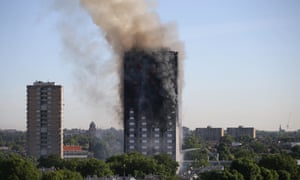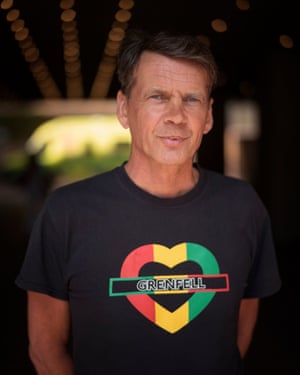The Grenfell Tower resident who issued warnings in 2016 that disaster would strike has predicted that every part of the decision-making process before the fire will be exposed as “rotten and cancerous” during the public inquiry, which starts its first phase on Monday.
Edward Daffarn has given his first newspaper interview about the night of the blaze and his attempts to hold the tower’s landlords to account over several years. During the interview he predicted the inquiry will reveal that everything that happened was avoidable and that the Royal Borough of Kensington and Chelsea (RBKC), the building owner, had a “feudal” relationship with residents.
Daffarn, 56, escaped from the 13th floor and has been helping the Metropolitan Police with their criminal investigation. He will give evidence to the public inquiry which will move from commemorations of victims to hearing about the fire and its causes, beginning with expert reports commissioned by the inquiry, which are expected to run to more than 2,000 pages.
The inquiry’s chair, Sir Martin Moore-Bick, will hear opening statements this week from RBKC and Kensington and Chelsea Tenants Management Organisation (KCTMO), the landlord. The cladding subcontractor, Harley Facades, and Arconic and Celotex, which made the panels and insulation will make statements through lawyers, as will the London Fire Brigade, the Fire Brigades Union and Behailu Kebede, in whose fourth floor flat the fire started.
The first phase will examine events on the night of the fire, how it spread and the emergency response. It is scheduled to run until the end of October. It will then move on to events leading up to the fire including the refurbishment programme from 2014 to 2016, during which time the Grenfell Action Blog, which Daffarn co-authored with Francis O’Connor, made repeated warnings that things were going wrong.
Daffarn, a mental health social worker who lived in Grenfell Tower for 16 years, wrote eight months before the fire: “Only a catastrophic event will expose the ineptitude and incompetence of our landlord, the KCTMO, and bring an end to the dangerous living conditions and neglect of health and safety legislation that they inflict upon their tenants and leaseholders.”
Speaking to the Guardian, he said: “Think of a typical landlord relationship with responsibilities, duties and care and forget that. It was either adversarial or hands-off. I can’t begin to express the level of contempt they had for us residents. We were the barrier to the big pot of money.”
The KCTMO declined to comment. Elizabeth Campbell, the leader of RBKC, said it would, in future, “engage our communities in council decision-making so those voices really count”.
“Every single link in this chain is going to be found to be rotten and cancerous,” Daffarn said. “The government didn’t implement the inquest recommendations after the Lakanal House fire where six people died in 2009. Had they done that Grenfell wouldn’t have happened. RBKC failed to carry out scrutiny of the TMO.
“The way the TMO operated, the handling of the contracts, the construction, through to the building regs, the materials that were used, the consultation process.”
When asked what links these failures, he said: “Greed, lack of respect, lack of humanity. It is the opposite of everything it should be. This is housing as a commodity to be exploited. It is not only in RBKC, it is what housing has become.”
Daffarn was dubbed “the prophet of Grenfell” after his blog published the warning that “only an incident that results in serious loss of life of KCTMO residents will allow the external scrutiny to occur” and that “a serious fire in a tower block or similar high-density residential property is the most likely reason that those who wield power at the KCTMO will be found out and brought to justice”.
He said “the blog wasn’t a prophecy, it was a prediction”, based on years of attempting to challenge the TMO and council and claimed he was treated with disdain by officials and local politicians over several years.

He said that when he and others secured an audience with the council’s housing committee to raise issues about refurbishment works, their presentation, which was only set to run for six minutes, was cut short; and that when he raised issues he was once told: “Who voted for you? What gives you the right to complain?”
He also said he was once sent a solicitor’s letter threatening him with court action when he questioned some of the refurbishment works being carried out by the TMO. Sources at the TMO said they had found no record of this.
Daffarn painted a picture of the council and the KCTMO working closely together to maximise the financial efficiency of Grenfell rather than caring for it as a community of more than 120 households. But he claims this was done without accountability as RBKC failed to properly oversee the KCTMO, which in turn ignored residents.
“They had found a way of exploiting our rent and contracts,” he said of the TMO. “The only time they would ever function was if you were behind on your rent. If you wanted to raise a complaint, say about your bathroom, you would never hear from them.”
He said officials showed the “patronising disposition of unaccountable power”, a quote from the Bishop of Liverpool’s report into the treatment of the Hillsborough disaster victims.
When KCTMO’s role was handed back to the council after the disaster, it had a backlog of at least 3,500 repairs.
“There were other tower blocks, Adair House and Hazelwood [run by KCTMO], where there had been fires and there were still outstanding enforcement orders,” he said. “We knew all of this. We were writing emails to the London Fire Brigade about fire safety, we knew our landlord was non-functioning and not capable of doing a proper job. And the people meant to be scrutinising them were not doing that. When the fire happened it was unimaginable in its horror, but it wasn’t unpredictable.”
He also said the KCTMO blocked residents’ access to information about the refurbishment, which could have allowed them to raise the alarm about the cladding. It refused their Freedom of Information request for the minutes of meetings with the contractors and architects on the basis that it was not subject to the Freedom of Information Act, even though on occasion it had released information under the act.
“We would have discovered that the cladding had been changed and we would have raised hell,” Daffarn said. “We wanted [the minutes] because we didn’t trust them. Maybe they knew that if they gave that information they would be rumbled for ... cost-cutting.”
A KCTMO spokesperson had previously said: “Kensington & Chelsea Tenant Management Organisation is a private company limited by guarantee and is therefore not a body which is subject to the Freedom of Information Act.”

Elizabeth Campbell, leader of Kensington and Chelsea council, said: “These important matters will be looked at by the public inquiry. The important thing for me now and in the future is that we are properly held to account by the people we serve. And we will be judged by what we do and not what we say. We will ensure that we listen to all residents and support the full range of voices to be heard. We will engage our communities in council decision-making, so those voices really count. And we will take decisions in an open and transparent way.”
Daffarn said he believes “people need to go to jail and companies need to be found guilty of corporate manslaughter”.
“But people will come out of jail so we need cultural change,” he said.
At about 1.10am on 14 June 2017, Daffarn was listening to the radio in bed. He heard his neighbour’s smoke alarm beeping, but presumed he’d burned his dinner. Five minutes later there was shouting on the landing, which wasn’t normal for Grenfell. He opened the front door and smoke came billowing in so he slammed it shut. He realised this was serious. A couple of minutes later his phone rang. It was his neighbour shouting: “Get the fuck out!” Daffarn had been inclined to follow the stay-put policy, but the neighbour’s tone persuaded him otherwise. He wrapped a wet towel around his face and ventured out.
“It was just black. I couldn’t see anything,” Daffarn said. “I went to where the emergency exit is.” He patted his hands against the wall but couldn’t find it and panicked, dropping the towel. He started to breathe in the smoke, and thought he was in severe trouble.
“At that moment a fireman came in and pulled me out into the stairwell and I ran for my life and got out. I was three breaths away from not making it out.”
He was incredibly lucky because there were only a few firemen in the building at that time, he said. It transpired that the hall was filled with smoke because one of his neighbours had fled but his door didn’t have a fire safety closer on it.
Daffarn was one of the first out and had only seen a couple of others fleeing. Some were refusing to leave. “I saw the building catastrophically ablaze, people at the windows,” he said. “The way we were treated that evening. We were left. No one came to help us.
“The police were telling us to go away, ambulance workers shouted at us to go home, they said some buses were coming to pick us up, then you had the riot police running past us. We were outside until the early hours until the rugby club came to rescue us. Eight hours later there was no one there. No authority, no plan.”